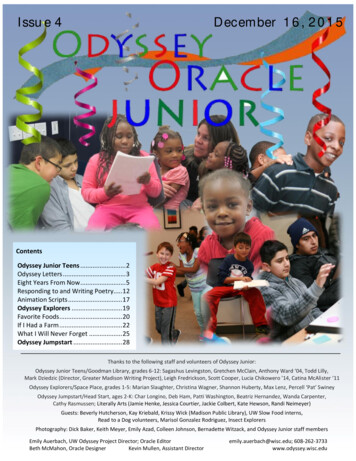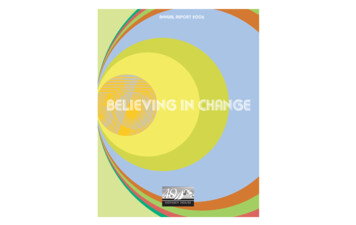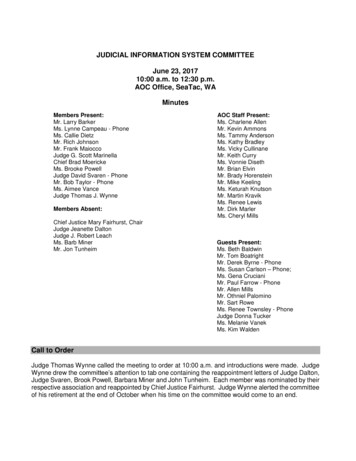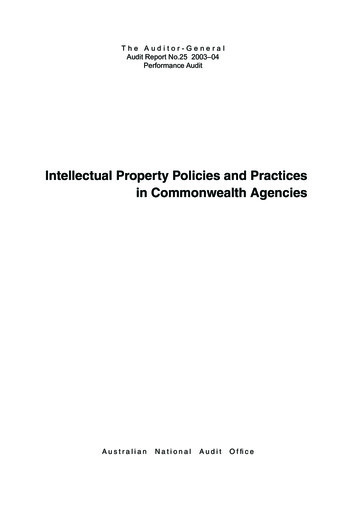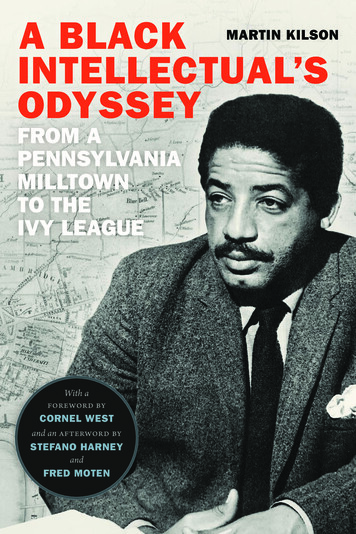
Transcription
A BLACKINTELLECTUAL’SODYSSEYMARTIN KILSONFROM APENNSYLVANIAMILLTOWNTO THEIVY LEAGUEWith aforeword byCORNEL WESTand an afterword bySTEFANO HARNEYandFRED MOTEN
A BLACK INTELLECTUAL’S ODYSSEY
Martin Kilson, 1969
A BLACKINTELLECTUAL’SODYSSEYFROM APENNSYLVANIAMILLTOWNTO THEIVY LEAGUEMARTIN KILSONWith a foreword by Cornel WestAnd an afterword by Stefano Harney and Fred Motenduke university press · durham and london · 2021
2021 duke university pressAll rights reservedPrinted in the United States of Amer i ca on acid- free paper Designed by Matthew TauchTypeset in Arno Pro Regular and ITC Franklin Gothic Stdby Westchester Publishing ServicesLibrary of Congress Cataloging-in-Publication DataNames: Kilson, Martin, author. West, Cornel, writer of foreword. Harney, Stefano, [date] writer of afterword. Moten, Fred, writer ofafterword.Title: A Black intellectual’s odyssey : from a Pennsylvania milltownto the Ivy League / Martin Kilson ; with a foreword by Cornel West ;and an afterword by Stefano Harney and Fred Moten.Description: Durham : Duke University Press, 2021. Includesbibliographical references and index.Identifiers: LCCN 2020046921 (print)LCCN 2020046922 (ebook)ISBN 9781478013297 (hardcover)ISBN 9781478021513 (ebook)Subjects: LCSH: Kilson, Martin. African American politicalscientists—Biography. African American educators—Biography. African American college teachers—Biography. African Americans—Intellectual life—20th century.Classification: LCC JC274.5.K55 A3 2021 (print) LCC JC274.5.K55 (ebook) DDC 320.092 [B]—dc23LC record available at https://lccn.loc.gov/2020046921LC ebook record available at https://lccn.loc.gov/2020046922Cover art: Photograph of Martin Kilson, 1969.
for marionandjennifer, peter, and hannahandjacob, rhiana, maya, caila, zuri, and ciaran
CONTENTSForeword. The One and Only Martin Kilson · ixcornel westPreface · xiiiAcknowl edgments · xv1Growing Up in a Northern Black Community, 1930s–1940s · 12A Helping- Hand Ethos and Black Social Life, 1920s–1960s · 123Melting- Pot- Friendly Schools in My Hometown, 1920s–1960s · 294Black Youth and Social Mobility, 1920s–1960s · 405Ambler: A Twentieth- Century Com pany Town · 586Lincoln University, 1949–1953: Part I · 777Lincoln University, 1949–1953: Part II · 968Harvard: Gradu ate School and Teaching · 1199Maturation: Research and Scholarship · 134Epilogue. The Election of Barack Obama · 148Afterword. Notes on Professor Martin Luther Kilson’s Work · 161stefano harney and fred motenSelected List of Martin Kilson’s Writings · 173Notes · 177Bibliography · 187Index · 191Gallery appears after page 76
FOREWORDThe One and Only Martin Kilsoncornel westThis historic memoir provides a rich and riveting glimpse into the life ofan unpre ce dented figure in the American acad emy, modern scholarship,and Black intellectual history. Like his great pre de ces sor W. E. B. DuBois, Martin Kilson tells his story within the contexts of communitiesand institutions, families and civic associations, persons and social movements. From the heartfelt dedication to his intellectual companion andloving wife, Marion, his marvelous and mature c hildren, and his blessedgrandchildren and great- grandchild, to his analytical reflections on BarackObama’s history- making election, Kilson takes us on a fascinating journeyfrom a small northern com pany town in Pennsylvania to the heights ofHarvard University. His style is quintessentially Kilsonesque.Kilson’s thick descriptions of the complex ways in which socialstructures shaped his lived experiences and those of his friends and family give us a vital sense of his mid- t wentieth- century upbringing in Ambler. From his free Negro roots, Black church foundations, and lower- middle- class sensibilities, Kilson brings us into his ever- changing world,which enabled his own maturation yet fell short of any collective liberation(especially of poor people). His “we” consciousness— a “we” that is demo cratic in content and cosmopolitan in character as he matures—is aided bymulticultural solidarities (on the Mattison school playground and as partof the Ambler Tigers athletic team) and abetted by multiracial alliances( under the auspices of “wasp acceptability” and “liberal civic activism”).He is deeply shaped by the “helping- hand ethos” of the best of Black culture and forever harsh on the “status climbing” of the worst of middle- classculture. Needless to say, Kilson never loses sight of white paternalism—in itsbenevolent or dictatorial forms— nor the open- mindedness of the best ofwhite fellow citizens. In short, Kilson is a consummate humanist in his
shaping and in how he shapes o thers. Yet this sentence of modesty echoesthroughout his memoir: “But enough about me.”An au then tic intellectual humility and curiosity drive this text. He daresto embark on adventures and uncharted territories—in mind, heart, soul,and body. But he does not flaunt his courage nor applaud his brilliance.The painful divorce of his devoted parents is handled with gentle care. Andthe joy of his beloved mother, Louisa, wedded to his incredible successis briefly mentioned and then poignantly left to linger on the page. Theprophetic words of his father, the Reverend Martin Luther Kilson Sr.,loom large: “Young Martin is going to be somebody someday!” Thoughsaid about the young Martin who sits on his shoeshine box, to the chagrin of his father’s church congregants, the sense of self- respect and self- confidence of father and son is deep.Kilson’s treatment of his pivotal years at Lincoln University is classicand resonates with the best novel of Black college life, Sundial (1986) byL. C. Morse (my dear brother and fellow Prince ton PhD, who also attendedHoward University and the London School of Economics). Kilson’s letterof defiance and disappointment in the relative lack of intellectual awakening and po liti cal consciousness— primarily due to fraternity- centered frivolous hedonism and cruel hazing— remains on the door of the library formonths. Yet the grand example of President Horace Mann Bond (who isabruptly fired with no advance notice in 1957) is a counterweight. And Kilson candidly acknowledges that many of these same fraternity men maturedand became serious professionals and citizens. We should add that manyof Kilson’s heroes were Alpha Phi Alpha men, such as W. E. B. Du Bois,Paul Robeson, Martin Luther King Jr., John Hope Franklin, and ThurgoodMarshall. Kilson’s stellar rec ord and brilliant achievements at Lincoln— first in his class and ac cep tance to Harvard— launch him even further intothe upper echelons of American society.It is revealing that Kilson spends more time on his small- town formation than on his Harvard education. He is aware of his history- makingbreakthroughs in gradu ate school and on the faculty. But he downplays hisPhD and monumental professorship at Harvard. Such firsts are meaningful to him, but what is more significant to him is how he uses his successand preserves his personal integrity and tenacity. Kilson exemplifies thewise insights of his fellow Harvardian William James, who noted in his 1903lecture “The True Harvard” that integrity is found not in the status- climbingof clever people who worship popu lar idols or pursue vulgar ends butrather in those who find joy in Veritas- seeking and in de pen dent thinkingxForeword
to better our world. Kilson was never a naive utopian thinker, yet he alsonever lost his zeal for truth and justice. He never ever sold his soul for amess of Harvard pottage.Kilson’s integrity and tenacity in the life of the mind are what struckme most deeply when I met him my freshman year at Harvard in the fallof 1970. I enrolled in his legendary Social Science 132 course on Blackpolitics; spent countless hours in his office at Apley Court, 16 HolyokeStreet; reveled with his precious family in Lexington, Mas sa chu setts,and Dublin, New Hampshire; learned to eat Chinese food and enjoyedtheir home cooking; and, most importantly, was enriched by a love fromhim and them that was and is sublime and supreme. Kilson taught me byexample for nearly fifty years what it is to be a serious intellectual withone’s own voice, style, and temperament. My own odyssey is unimaginablewithout his odyssey— just as we both are flawed yet fighting figures whofind joy in our commitment to Black honor and American democracy. Thismeans keeping alive the best of the great traditions of grand peoples, of everyday peoples of varying excellences, who with imagination, intelligence,and courage try to leave the world a little better than we found it. He did!Martin Luther Kilson Jr. was sui generis. We shall never see the likes ofhim again!Forewordxi
PREFACEThe idea of writing an autobiographical account of my life— starting withmy growing-up years and taking me all the way to where I find myselfnow, in a position to look back on it all— occurred to me quite soon a fterI retired from my teaching and research obligations at Harvard University in 2003. I quickly realized I didn’t want to focus only on the strictlypersonal features of my background; I wanted to relate something muchgreater, in fact, than my own life. To achieve this, I de cided to examine thesocietal agencies through which I evolved as a Black citizen in an oppressive,oligarchical, white- supremacist twentieth- century nation- state society; Iendeavored to use the context of my memoir to relate the broader historythat was unique to the small African American community in the Northeast that was my home during the 1930s and 1940s.Thus, in the following pages, I have also written a biography, essentially,of the two Black communities nestled in eastern Pennsylvania most familiarto me: the factory town of Ambler in which I spent my childhood andthe neighboring rural village town of Penllyn, both of which arose in thenineteenth century and progressed in special ways in the twentieth. Whileportraying facets of the social, civic, cultural, educational, and po liti cal patterns of these communities, I have si mul ta neously related my metamorphosis out of t hose patterns— which was largely dependent on my leavingthem. In the pages spanning my childhood years in the 1930s until 1949, theyear I entered college, the reader receives a twin portrait of the personaland institutional par ameters of my memoir. The remainder of the book relates the tale of my professional maturation, from my undergraduate yearsat Lincoln University, a Black college, to my years at Harvard University,first as a gradu ate student and then as a professor.As I write this preface, a basic observation comes to mind, one thatdefines the sort of African American community in which I grew up andwhich laid the groundwork for my outlook and my education: that African Americans such as my ancestors, who lived in the post– Civil War andReconstruction- era American society outside the South, w ere fortunate
to have had access to some degree of “demo cratic space” during the first erehalf of the twentieth c entury, space that their southern brethren wdeprived of. For them and for me during my youth, this meant freedomfrom the cruelest, most pernicious features of American racism that restricted the social life of Black people in the South during the Jim Crowera, a deadly and devastating period that spanned nearly three- quarters ofa century, from the late 1800s to the 1950s. For that 40 percent of Blackfolks who resided in the North and elsewhere across the country by 1950,racism was by no means absent, but they enjoyed—or, I should say, we enjoyed— a small mea sure of opportunity to participate in American societythat was almost totally denied southern Blacks because of the systematicimplementation and execution of racist practices and white- supremacistideas. I was fortunate to be born into a f amily and in a place that allowedme to pursue a path on which so many other African Americans of mygeneration, and even of today’s generation, have sadly never set foot.Call this memoir idiosyncratic, original, or what you w ill; my hope isthat readers will find within these pages a useful tale of one African American intellectual’s odyssey from the racist margins of twentieth- centuryAmer i ca to a rich and vital participatory presence in that same nation.xivPreface
ACKNOWL E DGMENTSSince Martin Kilson’s death in the spring of 2019, many helping hands haveassisted in transforming his manuscript into the book you hold. AlthoughMartin had the opportunity to review many of Julie Wolf ’s editorial suggestions, she completed her work on the manuscript during the summerof 2019, always taking care to retain Martin’s voice. Cornel West with hisintroduction and Stefano Harney and Fred Moten with their afterwordmade distinctive contributions to their former professor’s story. In addition, Fred and Stefano introduced the manuscript to Elizabeth Ault atDuke University Press. A fter the press’s ac cep tance of the manuscript forpublication, I have had the privilege of working with many of its staff members, especially Elizabeth Ault during the acquisitions pro cess and EllenGoldlust during the production pro cess. I am so grateful to each of t heseindividuals for their essential roles in the creation of A Black Intellectual’sOdyssey. I know how much Martin Kilson wanted his story to be publishedand how very pleased he would have been with this volume.marion d. de b. kilsonspring 2021
Rev. Martin Luther Kilson Sr. and Louisa Laws Kilson with their c hildren, 1933. MartinKilson is standing on the lowest step.
CONTENTS Foreword. The One and Only Martin Kilson · ix cornel west Preface · xiii Ac knowl e dgments · xv 1 Growing Up in a Northern Black Community, 1930s-1940s · 1 2 A Helping-Hand Ethos and Black Social Life, 1920s-1960s · 12 3 Melting-Pot-Friendly Schools in My Hometown, 1920s-1960s · 29 4 Black Youth and Social Mobility, 1920s-1960s · 40


